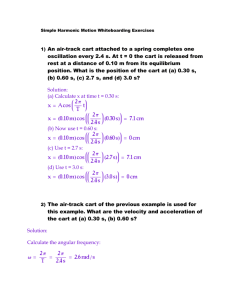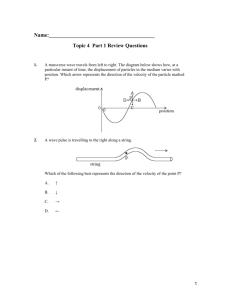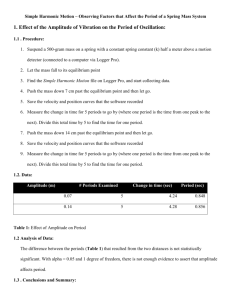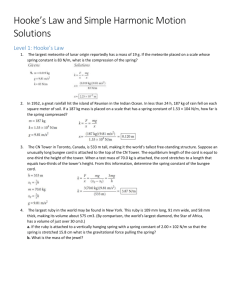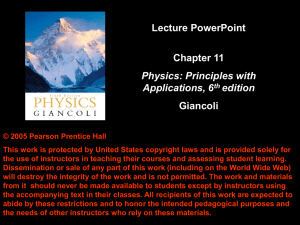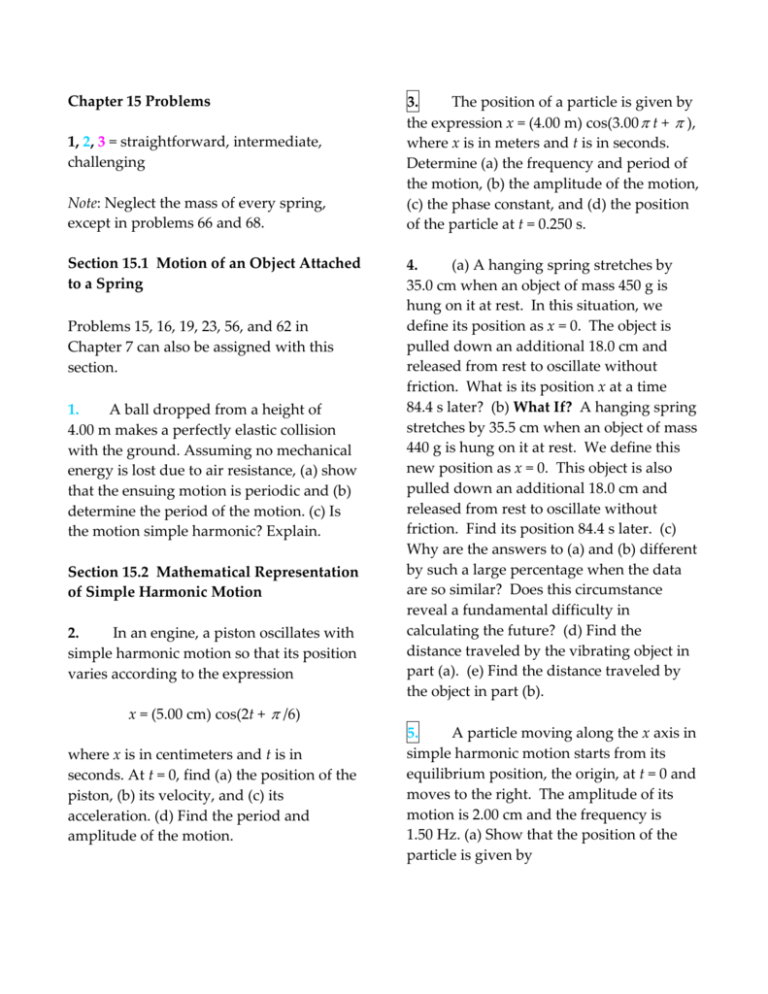
Chapter 15 Problems
1, 2, 3 = straightforward, intermediate,
challenging
Note: Neglect the mass of every spring,
except in problems 66 and 68.
Section 15.1 Motion of an Object Attached
to a Spring
Problems 15, 16, 19, 23, 56, and 62 in
Chapter 7 can also be assigned with this
section.
1.
A ball dropped from a height of
4.00 m makes a perfectly elastic collision
with the ground. Assuming no mechanical
energy is lost due to air resistance, (a) show
that the ensuing motion is periodic and (b)
determine the period of the motion. (c) Is
the motion simple harmonic? Explain.
Section 15.2 Mathematical Representation
of Simple Harmonic Motion
2.
In an engine, a piston oscillates with
simple harmonic motion so that its position
varies according to the expression
3.
The position of a particle is given by
the expression x = (4.00 m) cos(3.00 t + ),
where x is in meters and t is in seconds.
Determine (a) the frequency and period of
the motion, (b) the amplitude of the motion,
(c) the phase constant, and (d) the position
of the particle at t = 0.250 s.
4.
(a) A hanging spring stretches by
35.0 cm when an object of mass 450 g is
hung on it at rest. In this situation, we
define its position as x = 0. The object is
pulled down an additional 18.0 cm and
released from rest to oscillate without
friction. What is its position x at a time
84.4 s later? (b) What If? A hanging spring
stretches by 35.5 cm when an object of mass
440 g is hung on it at rest. We define this
new position as x = 0. This object is also
pulled down an additional 18.0 cm and
released from rest to oscillate without
friction. Find its position 84.4 s later. (c)
Why are the answers to (a) and (b) different
by such a large percentage when the data
are so similar? Does this circumstance
reveal a fundamental difficulty in
calculating the future? (d) Find the
distance traveled by the vibrating object in
part (a). (e) Find the distance traveled by
the object in part (b).
x = (5.00 cm) cos(2t + /6)
where x is in centimeters and t is in
seconds. At t = 0, find (a) the position of the
piston, (b) its velocity, and (c) its
acceleration. (d) Find the period and
amplitude of the motion.
5.
A particle moving along the x axis in
simple harmonic motion starts from its
equilibrium position, the origin, at t = 0 and
moves to the right. The amplitude of its
motion is 2.00 cm and the frequency is
1.50 Hz. (a) Show that the position of the
particle is given by
x = (2.00 cm) sin(3.00 t)
Determine (b) the maximum speed and the
earliest time (t > 0) at which the particle has
this speed, (c) the maximum acceleration
and the earliest time (t > 0) at which the
particle has this acceleration, and (d) the
total distance traveled between t = 0 and
t = 1.00 s.
6.
The initial position, velocity, and
acceleration of an object moving in simple
harmonic motion are xi, vi, and ai; the
angular frequency of oscillation is . (a)
Show that the position and velocity of the
object for all time can be written as
x(t) x i cos t
v i
sin t
v(t) = – xi sin t + vi cos t
(b) If the amplitude of the motion is A,
show that
v2 – ax = vi2 – ai xi = 2A2
7.
A simple harmonic oscillator takes
12.0 s to undergo five complete vibrations.
Find (a) the period of its motion, (b) the
frequency in hertz, and (c) the angular
frequency in radians per second.
8.
A vibration sensor, used in testing a
washing machine, consists of a cube of
aluminum 1.50 cm on edge mounted on one
end of a strip of spring steel (like a hacksaw
blade) that lies in a vertical plane. The
mass of the strip is small compared to that
of the cube, but the length of the strip is
large compared to the size of the cube. The
other end of the strip is clamped to the
frame of the washing machine, which is not
operating. A horizontal force of 1.43 N
applied to the cube is required to hold it
2.75 cm away from its equilibrium position.
If the cube is released, what is its frequency
of vibration?
9.
A 7.00 kg object is hung from the
bottom end of a vertical spring fastened to
an overhead beam. The object is set into
vertical oscillations having a period of
2.60 s. Find the force constant of the spring.
10.
A piston in a gasoline engine is in
simple harmonic motion. If the extremes of
its position relative to its center point are
5.00 cm, find the maximum velocity and
acceleration of the piston when the engine
is running at the rate of 3 600 rev/min.
11.
A 0.500-kg object attached to a
spring with a force constant of 8.00 N/m
vibrates in simple harmonic motion with an
amplitude of 10.0 cm. Calculate (a) the
maximum value of its speed and
acceleration, (b) the speed and acceleration
when the object is 6.00 cm from the
equilibrium position, and (c) the time
interval required for the object to move
from x = 0 to x = 8.00 cm.
12.
A 1.00-kg glider attached to a spring
with a force constant of 25.0 N/m oscillates
on a horizontal, frictionless air track. At
t = 0 the glider is released from rest at
x = –3.00 cm. (That is, the spring is
compressed by 3.00 cm.) Find (a) the period
of its motion, (b) the maximum values of its
speed and acceleration, and (c) the position,
velocity, and acceleration as functions of
time.
16.
A 200-g block is attached to a
horizontal spring and executes simple
harmonic motion with a period of 0.250 s. If
the total energy of the system is 2.00 J, find
(a) the force constant of the spring and (b)
the amplitude of the motion.
13.
A 1.00-kg object is attached to a
horizontal spring. The spring is initially
stretched by 0.100 m, and the object is
released from rest there. It proceeds to
move without friction. The next time the
speed of the object is zero is 0.500 s later.
What is the maximum speed of the object?
17.
An automobile having a mass of
1 000 kg is driven into a brick wall in a
safety test. The bumper behaves like a
spring of force constant 5.00 106 N/m and
compresses 3.16 cm as the car is brought to
rest. What was the speed of the car before
impact, assuming that no mechanical
energy is lost during impact with the wall?
14.
A particle that hangs from a spring
oscillates with an angular frequency .
The spring is suspended from the ceiling of
an elevator car and hangs motionless
(relative to the elevator car) as the car
descends at a constant speed v. The car
then stops suddenly. (a) With what
amplitude does the particle oscillate? (b)
What is the equation of motion for the
particle? (Choose the upward direction to
be positive.)
Section 15.3 Energy of the Simple
Harmonic Oscillator
15.
A block of unknown mass is
attached to a spring with a spring constant
of 6.50 N/m and undergoes simple
harmonic motion with an amplitude of
10.0 cm. When the block is halfway
between its equilibrium position and the
endpoint, its speed is measured to be 30.0
cm/s. Calculate (a) the mass of the block,
(b) the period of the motion, and (c) the
maximum acceleration of the block.
18.
A block-spring system oscillates with
an amplitude of 3.50 cm. If the spring
constant is 250 N/m and the mass of the
block is 0.500 kg, determine (a) the
mechanical energy of the system, (b) the
maximum speed of the block, and (c) the
maximum acceleration.
19.
A 50.0-g object connected to a spring
with a force constant of 35.0 N/m oscillates
on a horizontal, frictionless surface with an
amplitude of 4.00 cm. Find (a) the total
energy of the system and (b) the speed of
the object when the position is 1.00 cm.
Find (c) the kinetic energy and (d) the
potential energy when the position is
3.00 cm.
20.
A 2.00-kg object is attached to a
spring and placed on a horizontal, smooth
surface. A horizontal force of 20.0 N is
required to hold the object at rest when it is
pulled 0.200 m from its equilibrium
position (the origin of the x axis). The object
is now released from rest with an initial
position of xi = 0.200 m, and it subsequently
undergoes simple harmonic oscillations.
Find (a) the force constant of the spring, (b)
the frequency of the oscillations, and (c) the
maximum speed of the object. Where does
this maximum speed occur? (d) Find the
maximum acceleration of the object. Where
does it occur? (e) Find the total energy of
the oscillating system. Find (f) the speed
and (g) the acceleration of the object when
its position is equal to one third of the
maximum value.
21.
The amplitude of a system moving
in simple harmonic motion is doubled.
Determine the change in (a) the total
energy, (b) the maximum speed, (c) the
maximum acceleration, and (d) the period.
22.
A 65.0-kg bungee jumper steps off a
bridge with a light bungee cord tied to
herself and to the bridge. The unstretched
length of the cord is 11.0 m. She reaches the
bottom of her motion 36.0 m below the
bridge before bouncing back. Her motion
can be separated into an 11.0 m free fall and
a 25.0 m section of simple harmonic
oscillation. (a) For what time interval is she
in free fall? (b) Use the principle of
conservation of energy to find the spring
constant of the bungee cord. (c) What is the
location of the equilibrium point where the
spring force balances the force of gravity
acting on the jumper? Note that this point
is taken as the origin in our mathematical
description of simple harmonic oscillation.
(d) What is the angular frequency of the
oscillation? (e) What time interval is
required for the cord to stretch by 25.0 m?
(f) What is the total time interval for the
entire 36.0 m drop?
23.
A particle executes simple harmonic
motion with an amplitude of 3.00 cm. At
what position does its speed equal one half
of its maximum speed?
24.
A cart attached to a spring with
constant 3.24 N/m vibrates with position
given by x = (5.00 cm) cos(3.60t rad/s). (a)
During the first cycle, for 0 < t < 1.75 s, just
when is the system’s potential energy
changing most rapidly into kinetic energy?
(b) What is the maximum rate of energy
transformation?
Section 15.4 Comparing Simple Harmonic
Motion with Uniform Circular Motion
25.
While riding behind a car traveling
at 3.00 m/s, you notice that one of the car's
tires has a small hemispherical bump on its
rim, as in Figure P15.25. (a) Explain why
the bump, from your viewpoint behind the
car, executes simple harmonic motion. (b) If
the radii of the car's tires are 0.300 m, what
is the bump's period of oscillation?
to the floor and that its period is 12.0 s. (a)
How tall is the tower? (b) What If? If this
pendulum is taken to the Moon, where the
free-fall acceleration is 1.67 m/s2, what is its
period there?
Figure P15.25
26.
Consider the simplified single-piston
engine in Figure P15.26. If the wheel rotates
with constant angular speed, explain why
the piston rod oscillates in simple harmonic
motion.
28.
A "seconds pendulum" is one that
moves through its equilibrium position
once each second. (The period of the
pendulum is precisely 2 s.) The length of a
seconds pendulum is 0.992 7 m at Tokyo,
Japan and 0.994 2 m at Cambridge,
England. What is the ratio of the free-fall
accelerations at these two locations?
29.
A rigid steel frame above a street
intersection supports standard traffic lights,
each of which is hinged to hang
immediately below the frame. A gust of
wind sets a light swinging in a vertical
plane. Find the order of magnitude of its
period. State the quantities you take as
data and their values.
30.
The angular position of a pendulum
is represented by the equation
= (0.320 rad) cos t, where is in
radians and = 4.43 rad/s. Determine the
period and length of the pendulum.
Figure P15.26
Section 15.5 The Pendulum
Problem 60 in Chapter 1 can also be
assigned with this section.
27.
A man enters a tall tower, needing to
know its height. He notes that a long
pendulum extends from the ceiling almost
31.
A simple pendulum has a mass of
0.250 kg and a length of 1.00 m. It is
displaced through an angle of 15.0 and
then released. What are (a) the maximum
speed, (b) the maximum angular
acceleration, and (c) the maximum
restoring force? What If? Solve this
problem by using the simple harmonic
motion model for the motion of the
pendulum, and then solve the problem
more precisely by using more general
principles.
32.
Review problem. A simple
pendulum is 5.00 m long. (a) What is the
period of small oscillations for this
pendulum if it is located in an elevator
accelerating upward at 5.00 m/s2? (b) What
is its period if the elevator is accelerating
downward at 5.00 m/s2? (c) What is the
period of this pendulum if it is placed in a
truck that is accelerating horizontally at
5.00 m/s2?
33.
A particle of mass m slides without
friction inside a hemispherical bowl of
radius R. Show that, if it starts from rest
with a small displacement from
equilibrium, the particle moves in simple
harmonic motion with an angular
frequency equal to that of a simple
pendulum of length R. That is,
g/ R .
34.
A small object is attached to the end
of a string to form a simple pendulum. The
period of its harmonic motion is measured
for small angular displacements and three
lengths, each time clocking the motion with
a stopwatch for 50 oscillations. For lengths
of 1.000 m, 0.750 m, and 0.500 m, total times
of 99.8 s, 86.6 s, and 71.1 s are measured for
50 oscillations. (a) Determine the period of
motion for each length. (b) Determine the
mean value of g obtained from these three
independent measurements, and compare it
with the accepted value. (c) Plot T2 versus L,
and obtain a value for g from the slope of
your best-fit straight-line graph. Compare
this value with that obtained in part (b).
35.
A physical pendulum in the form of
a planar body moves in simple harmonic
motion with a frequency of 0.450 Hz. If the
pendulum has a mass of 2.20 kg and the
pivot is located 0.350 m from the center of
mass, determine the moment of inertia of
the pendulum about the pivot point.
36.
A very light rigid rod with a length
of 0.500 m extends straight out from one
end of a meter stick. The stick is suspended
from a pivot at the far end of the rod and is
set into oscillation. (a) Determine the
period of oscillation. Suggestion: Use the
parallel-axis theorem from Section 10.5. (b)
By what percentage does the period differ
from the period of a simple pendulum
1.00 m long?
37.
Consider the physical pendulum of
Figure 15.18. (a) If its moment of inertia
about an axis passing through its center of
mass and parallel to the axis passing
through its pivot point is ICM, show that its
period is
I CM md 2
T 2
mgd
where d is the distance between the pivot
point and center of mass. (b) Show that the
period has a minimum value when d
satisfies md2 = ICM.
38.
A torsional pendulum is formed by
taking a meter stick of mass 2.00 kg, and
attaching to its center a wire. With its upper
end clamped, the vertical wire supports the
stick as the stick turns in a horizontal plane.
If the resulting period is 3.00 minutes, what
is the torsion constant for the wire?
39.
A clock balance wheel (Fig. P15.39)
has a period of oscillation of 0.250 s. The
wheel is constructed so that its mass of
20.0 g is concentrated around a rim of
radius 0.500 cm. What are (a) the wheel's
moment of inertia, and (b) the torsion
constant of the attached spring?
After 1 000 s, its amplitude has been
reduced by friction to 5.50. What is the
value of b/2m?
42.
Show that Equation 15.32 is a
solution of Equation 15.31 provided that
b2 < 4mk.
43.
An 10.6-kg object oscillates at the
end of a vertical spring which has a spring
constant of 2.05 104 N/m. The effect of air
resistance is represented by the damping
coefficient b = 3.00 N·s/m. (a) Calculate the
frequency of the damped oscillation. (b) By
what percentage does the amplitude of the
oscillation decrease in each cycle? (c) Find
the time interval that elapses while the
energy of the system drops to 5.00% of its
initial value.
Section 15.7 Forced Oscillations
Figure P15.39
Section 15.6 Damped Oscillations
40.
Show that the time rate of change of
mechanical energy for a damped, undriven
oscillator is given by dE/dt = –bv2 and hence
is always negative. Proceed as follows:
Differentiate the expression for the
mechanical energy of an oscillator,
E 12 mv 2 21 kx 2 , and use
Equation 15.31.
41.
A pendulum with a length of 1.00 m
is released from an initial angle of 15.0.
44.
The front of her sleeper wet from
teething, a baby rejoices in the day by
crowing and bouncing up and down in her
crib. Her mass is 12.5 kg and the crib
mattress can be modeled as a light spring
with force constant 4.30 kN/m. (a) The
baby soon learns to bounce with maximum
amplitude and minimum effort by bending
her knees at what frequency? (b) She learns
to use the mattress as a trampoline—losing
contact with it for part of each cycle—when
her amplitude exceeds what value?
45.
A 2.00-kg object attached to a spring
moves without friction and is driven by an
external force F = (3.00 N) sin(2 t). If the
force constant of the spring is 20.0 N/m,
determine (a) the period and (b) the
amplitude of the motion.
46.
Considering an undamped, forced
oscillator (b = 0), show that Equation 15.35
is a solution of Equation 15.34, with an
amplitude given by Equation 15.36.
47.
A weight of 40.0 N is suspended
from a spring that has a force constant of
200 N/m. The system is undamped and is
subjected to a harmonic driving force of
frequency 10.0 Hz, resulting in a forcedmotion amplitude of 2.00 cm. Determine
the maximum value of the driving force.
48.
Damping is negligible for a 0.150-kg
object hanging from a light 6.30-N/m
spring. A sinusoidal force with an
amplitude of 1.70 N drives the system. At
what frequency will the force make the
object vibrate with an amplitude of
0.440 m?
49.
You are a research biologist. You
take your emergency pager along to a fine
restaurant. You switch the small pager to
vibrate instead of beep, and you put it into
a side pocket of your suit coat. The arm of
your chair presses the light cloth against
your body at one spot. Fabric with a length
of 8.21 cm hangs freely below that spot,
with the pager at the bottom. A coworker
urgently needs instructions and calls you
from your laboratory. The motion of the
pager makes the hanging part of your coat
swing back and forth with remarkably large
amplitude. The waiter and nearby diners
notice immediately and fall silent. Your
daughter pipes up and says, accurately
enough, “Daddy, look! Your cockroaches
must have gotten out again!” Find the
frequency at which your pager vibrates.
50.
Four people, each with a mass of
72.4 kg, are in a car with a mass of 1 130 kg.
An earthquake strikes. The driver manages
to pull off the road and stop, as the vertical
oscillations of the ground surface make the
car bounce up and down on its suspension
springs. When the frequency of the shaking
is 1.80 Hz, the car exhibits a maximum
amplitude of vibration. The earthquake
ends and the four people leave the car as
fast as they can. By what distance does the
car’s undamaged suspension lift the car
body as the people get out?
Additional Problems
51.
A small ball of mass M is attached to
the end of a uniform rod of equal mass M
and length L that is pivoted at the top (Fig.
P15.51). (a) Determine the tensions in the
rod at the pivot and at the point P when the
system is stationary. (b) Calculate the
period of oscillation for small
displacements from equilibrium, and
determine this period for L = 2.00 m.
(Suggestions: Model the object at the end of
the rod as a particle and use Eq. 15.28.)
Figure P15.51
52.
An object of mass m1 = 9.00 kg is in
equilibrium while connected to a light
spring of constant k = 100 N/m that is
fastened to a wall as shown in Figure
P15.52a. A second object, m2 = 7.00 kg, is
slowly pushed up against m1, compressing
the spring by the amount A = 0.200 m, (see
Figure P15.52b). The system is then
released, and both objects start moving to
the right on the frictionless surface. (a)
When m1 reaches the equilibrium point, m2
loses contact with m1 (see Fig. P15.5c) and
moves to the right with speed v. Determine
the value of v. (b) How far apart are the
objects when the spring is fully stretched
for the first time (D in Fig. P15.52d)?
(Suggestion: First determine the period of
oscillation and the amplitude of the
m1–spring system after m2 loses contact with
m1.)
Figure P15.52
53.
A large block P executes horizontal
simple harmonic motion as it slides across a
frictionless surface with a frequency f = 1.50
Hz. Block B rests on it, as shown in Figure
P15.53, and the coefficient of static friction
between the two is s = 0.600. What
maximum amplitude of oscillation can the
system have if block B is not to slip?
Figure P15.53 Problems 53 and 54.
54.
A large block P executes horizontal
simple harmonic motion as it slides across a
frictionless surface with a frequency f.
Block B rests on it, as shown in Figure
P15.53, and the coefficient of static friction
between the two is s. What maximum
amplitude of oscillation can the system
have if the upper block is not to slip?
55.
The mass of the deuterium molecule
(D2) is twice that of the hydrogen molecule
(H2). If the vibrational frequency of H2 is
1.30 1014 Hz, what is the vibrational
frequency of D2? Assume that the “spring
constant” of attracting forces is the same for
the two molecules.
56.
A solid sphere (radius = R) rolls
without slipping in a cylindrical trough
(radius = 5R) as shown in Figure P15.56.
Show that, for small displacements from
equilibrium perpendicular to the length of
the trough, the sphere executes simple
harmonic motion with a period
T 2 28R / 5g .
Figure P15.56
57.
A light, cubical container of volume
3
a is initially filled with a liquid of mass
density . The cube is initially supported
by a light string to form a simple pendulum
of length Li, measured from the center of
mass of the filled container, where Li >> a.
The liquid is allowed to flow from the
bottom of the container at a constant rate
(dM/dt). At any time t, the level of the fluid
in the container is h and the length of the
pendulum is L (measured relative to the
instantaneous center of mass). (a) Sketch
the apparatus and label the dimensions a, h,
Li, and L. (b) Find the time rate of change of
the period as a function of time t. (c) Find
the period as a function of time.
58.
After a thrilling plunge, bungeejumpers bounce freely on the bungee cord
through many cycles. After the first few
cycles, the cord does not go slack. Your
little brother can make a pest of himself by
figuring out the mass of each person, using
a proportion which you set up by solving
this problem: An object of mass m is
oscillating freely on a vertical spring with a
period T. An object of unknown mass m’ on
the same spring oscillates with a period T'.
Determine (a) the spring constant and (b)
the unknown mass.
59.
A pendulum of length L and mass M
has a spring of force constant k connected to
it at a distance h below its point of
suspension (Fig. P15.59). Find the frequency
of vibration of the system for small values
of the amplitude (small ). Assume the
vertical suspension of length L is rigid, but
ignore its mass.
5.00 kg and the spring has a force constant
of 100 N/m.
Figure P15.59
60.
A particle with a mass of 0.500 kg is
attached to a spring with a force constant of
50.0 N/m. At time t = 0 the particle has its
maximum speed of 20.0 m/s and is moving
to the left. (a) Determine the particle’s
equation of motion, specifying its position
as a function of time. (b) Where in the
motion is the potential energy three times
the kinetic energy? (c) Find the length of a
simple pendulum with the same period. (d)
Find the minimum time interval required
for the particle to move from x = 0 to
x = 1.00 m.
61.
A horizontal plank of mass m and
length L is pivoted at one end. The plank’s
other end is supported by a spring of force
constant k (Fig P15.61). The moment of
inertia of the plank about the pivot is
1
3
mL2 . The plank is displaced by a small
angle from its horizontal equilibrium
position and released. (a) Show that it
moves with simple harmonic motion with
an angular frequency = 3k/m . (b)
Evaluate the frequency if the mass is
Figure P15.61
62.
Review problem. A particle of mass
4.00 kg is attached to a spring with a force
constant of 100 N/m. It is oscillating on a
horizontal frictionless surface with an
amplitude of 2.00 m. A 6.00-kg object is
dropped vertically on top of the 4.00-kg
object as it passes through its equilibrium
point. The two objects stick together. (a)
By how much does the amplitude of the
vibrating system change as a result of the
collision? (b) By how much does the period
change? (c) By how much does the energy
change? (d) Account for the change in
energy.
63.
A simple pendulum with a length of
2.23 m and a mass of 6.74 kg is given an
initial speed of 2.06 m/s at its equilibrium
position. Assume it undergoes simple
harmonic motion, and determine its (a)
period, (b) total energy, and (c) maximum
angular displacement.
64.
Review problem. One end of a light
spring with force constant 100 N/m is
attached to a vertical wall. A light string is
tied to the other end of the horizontal
spring. The string changes from horizontal
to vertical as it passes over a solid pulley of
diameter 4.00 cm. The pulley is free to turn
on a fixed smooth axle. The vertical section
of the string supports a 200-g object. The
string does not slip at its contact with the
pulley. Find the frequency of oscillation of
the object if the mass of the pulley is (a)
negligible, (b) 250 g, and (c) 750 g.
65.
People who ride motorcycles and
bicycles learn to look out for bumps in the
road, and especially for washboarding, a
condition in which many equally spaced
ridges are worn into the road. What is so
bad about washboarding? A motorcycle
has several springs and shock absorbers in
its suspension, but you can model it as a
single spring supporting a block. You can
estimate the force constant by thinking
about how far the spring compresses when
a big biker sits down on the seat. A
motorcyclist traveling at highway speed
must be particularly careful of washboard
bumps that are a certain distance apart.
What is the order of magnitude of their
separation distance? State the quantities
you take as data and the values you
measure or estimate for them.
66.
A block of mass M is connected to a
spring of mass m and oscillates in simple
harmonic motion on a horizontal,
frictionless track (Fig. P15.66). The force
constant of the spring is k and the
equilibrium length is . Assume that all
portions of the spring oscillate in phase and
that the velocity of a segment dx is
proportional to the distance x from the
fixed end; that is, vx = (x/ )v. Also, note that
the mass of a segment of the spring is
dm = (m/ )dx. Find (a) the kinetic energy of
the system when the block has a speed v,
and (b) the period of oscillation.
Figure P15.66
67.
A ball of mass m is connected to two
rubber bands of length L, each under
tension T, as in Figure P15.67. The ball is
displaced by a small distance y
perpendicular to the length of the rubber
bands. Assuming that the tension does not
change, show that (a) the restoring force is
–(2T/L)y and (b) the system exhibits simple
harmonic motion with an angular
frequency 2T / mL .
Figure P15.67
68.
When a block of mass M, connected
to the end of a spring of mass ms = 7.40 g
and force constant k, is set into simple
harmonic motion, the period of its motion
is
T 2
M m s / 3
k
A two-part experiment is conducted with
the use of blocks of various masses
suspended vertically from the spring, as
shown in Figure P15.68. (a) Static
extensions of 17.0, 29.3, 35.3, 41.3, 47.1, and
49.3 cm are measured for M values of 20.0,
40.0, 50.0, 60.0, 70.0, and 80.0 g,
respectively. Construct a graph of Mg
versus x, and perform a linear least-squares
fit to the data. From the slope of your
graph, determine a value for k for this
spring. (b) The system is now set into
simple harmonic motion, and periods are
measured with a stopwatch. With
M = 80.0 g, the total time for 10 oscillations
is measured to be 13.41 s. The experiment is
repeated with M values of 70.0, 60.0, 50.0,
40.0, and 20.0 g, with corresponding times
for 10 oscillations of 12.52, 11.67, 10.67, 9.62,
and 7.03 s. Compute the experimental value
for T from each of these measurements. Plot
a graph of T2 versus M and determine a
value for k from the slope of the linear leastsquares fit through the data points.
Compare this value of k with that obtained
in part (a). (c) Obtain a value for ms from
your graph and compare it with the given
value of 7.40 g.
Figure P15.68
69.
A smaller disk of radius r and mass
m is attached rigidly to the face of a second
larger disk of radius R and mass M as
shown in Figure P15.69. The center of the
small disk is located at the edge of the large
disk. The large disk is mounted at its center
on a frictionless axle. The assembly is
rotated through a small angle from its
equilibrium position and released. (a) Show
that the speed of the center of the small disk
as it passes through the equilibrium
position is
1/ 2
Rg1 cos
v 2
2
M
/
m
r
/
R
2
(b) Show that the period of the motion is
1/ 2
M 2m R 2 mr2
T 2
2mgR
(a)
T 2
(b)
T 2
m k1 k 2
k 1 k2
m
k1 k 2
Figure P15.69
70.
Consider a damped oscillator
illustrated in Figures 15.21 and 15.22.
Assume the mass is 375 g, the spring
constant is 100 N/m, and b = 0.100 N·s/m.
(a) How long does it takes for the
amplitude to drop to half its initial value?
(b) What If? How long does it take for the
mechanical energy to drop to half its initial
value? (c) Show that, in general, the
fractional rate at which the amplitude
decreases in a damped harmonic oscillator
is half the fractional rate at which the
mechanical energy decreases.
71.
A block of mass m is connected to
two springs of force constants k1 and k2 as
shown in Figures P15.71a and P15.71b. In
each case, the block moves on a frictionless
table after it is displaced from equilibrium
and released. Show that in the two cases the
block exhibits simple harmonic motion
with periods
Figure P15.71
72.
A lobsterman’s buoy is a solid
wooden cylinder of radius r and mass M. It
is weighted at one end so that it floats
upright in calm sea water, having density
. A passing shark tugs on the slack rope
mooring the buoy to a lobster trap, pulling
the buoy down a distance x from its
equilibrium position and releasing it. Show
that the buoy will execute simple harmonic
motion if the resistive effects of the water
are neglected, and determine the period of
the oscillations.
73.
Consider a bob on a light stiff rod,
forming a simple pendulum of length
L = 1.20 m. It is displaced from the vertical
by an angle max and then released. Predict
the subsequent angular positions if max is
small or if it is large. Proceed as follows:
Set up and carry out a numerical method to
integrate the equation of motion for the
simple pendulum:
g
d 2
sin
dt 2
L
Take the initial conditions to be = max
and d /dt = 0 at t = 0. On one trial, choose
max = 5.00 and on another trial take
max = 100. In each case find the position
as a function of time. Using the same
values of max, compare your results for
with those obtained from
(t) = max cos t. How does the period
for the large value of max compare with
that for the small value of max? Note:
Using the Euler method to solve this
differential equation, you may find that the
amplitude tends to increase with time. The
fourth-order Runge-Kutta method would
be a better choice to solve the differential
equation. However, if you choose t small
enough, the solution using Euler’s method
can still be good.
74.
Your thumb squeaks on a plate you
have just washed. Your sneakers often
squeak on the gym floor. Car tires squeal
when you start or stop abruptly. You can
make a goblet sing by wiping your
moistened finger around its rim. As you
slide it across the table, a Styrofoam cup
may not make much sound, but it makes
the surface of some water inside it dance in
a complicated resonance vibration. When
chalk squeaks on a blackboard, you can see
that it makes a row of regularly spaced
dashes. As these examples suggest,
vibration commonly results when friction
acts on a moving elastic object. The
oscillation is not simple harmonic motion,
but is called stick-and-slip. This problem
models stick-and-slip motion.
A block of mass m is attached to a fixed
support by a horizontal spring with force
constant k and negligible mass (Fig. P15.74).
Hooke’s law describes the spring both in
extension and in compression. The block
sits on a long horizontal board, with which
it has coefficient of static friction s and a
smaller coefficient of kinetic friction k.
The board moves to the right at constant
speed v. Assume that the block spends
most of its time sticking to the board and
moving to the right, so that the speed v is
small in comparison to the average speed
the block has as it slips back toward the left.
(a) Show that the maximum extension of
the spring from its unstressed position is
very nearly given by smg/k. (b) Show
that the block oscillates around an
equilibrium position at which the spring is
stretched by kmg/k. (c) Graph the block’s
position versus time. (d) Show that the
amplitude of the block’s motion is
A
s k mg
k
(e) Show that the period of the block’s
motion is
T
2 s k mg
vk
m
k
(f) Evaluate the frequency of the motion if
s = 0.400, k = 0.250, m = 0.300 kg,
k = 12.0 N/m, and v = 2.40 cm/s. (g) What
If? What happens to the frequency if the
mass increases? (h) If the spring constant
increases? (i) If the speed of the board
increases? (j) If the coefficient of static
friction increases relative to the coefficient
of kinetic friction? Note that it is the excess
of static over kinetic friction that is
important for the vibration. ‘The squeaky
wheel gets the grease’ because even a
viscous fluid cannot exert a force of static
friction.
at a distance r from the center of the Earth
is pulled toward the center of the Earth
only by the mass within the sphere of
radius r (the reddish region in Fig. P15.75).
(a) Write Newton's law of gravitation for an
object at the distance r from the center of
the Earth, and show that the force on it is of
Hooke's law form, F = –kr, where the
effective force constant is k = (4/3) Gm.
Here is the density of the Earth, assumed
uniform, and G is the gravitational
constant. (b) Show that a sack of mail
dropped into the hole will execute simple
harmonic motion if it moves without
friction. When will it arrive at the other
side of the Earth?
Figure P15.74
75.
Review problem. Imagine that a
hole is drilled through the center of the
Earth to the other side. An object of mass m
© Copyright 2004 Thomson. All rights reserved.
Figure P15.75

